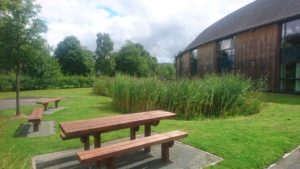
How to consider water management in your building design
Throughout August we are publishing a series of ‘how to’ blogs to help guide self-builders or developers in considering all aspects of the National Park’s special and unique qualities in their new building design. In this third blog we focus on how to consider water management in a design.
Here in the West of Scotland we can have beautiful summers but also plenty of rain. We need to take this into account when considering any applications for new development in the National Park.
If you imagine a site that has no buildings (or other hard surfaces), when rain falls the water will naturally seep into the ground. In incidents of heavy rain, small flushes, rivulets and sometimes temporary streams will take the water to the nearest watercourse or loch. In extreme conditions and on softer ground this may even lead to the creation of small erosion gullies. When buildings and parking areas are constructed, the rate in which this water discharges gets faster and there is less seepage into the ground. This can cause problems downstream, creating flash flood events with even more damage from erosion and gullies. Even in a rural place, water needs to be able to slowly release back into the water system to avoid flash floods.
To help combat this, the National Park Authority seeks developments which incorporate sustainable drainage to collect, store and release the water back on to site. Our new Design & Placemaking Guidance includes advice on surface water management and how to best incorporate sustainable drainage into your development.
As the guidance shows, we want to see more ponds and rain gardens that have added wildlife and landscape benefits. Our National Park Headquarters in Balloch has an example of such a pond, which also acts as part of a SUDS scheme, helping to clean the rain water of silt and other pollutants before it returns to the nearest water body. Our new Design & Placemaking Guidance includes advice on surface water management and how to best incorporate sustainable drainage into your development.

The guidance also requires proposals to consider removing existing culverts, realigning ditches and watercourse re-profiling to integrate an existing watercourse into a development proposal. This has lots of added benefits for wildlife and landscape.
More information on how to consider surface water management in your design can be found in our new Design & Placemaking Guidance.
Keep your eyes peeled throughout August as we publish more blogs on how to consider the special qualities of the National Park in your building design. Visit our planning advice and guidance pages to read these blogs as they are published.

